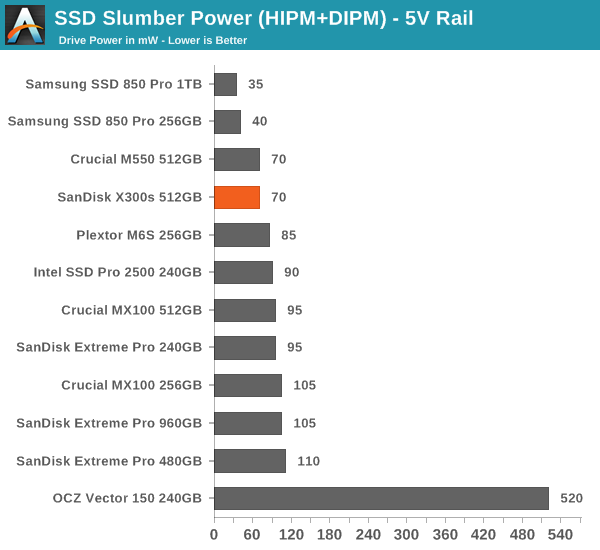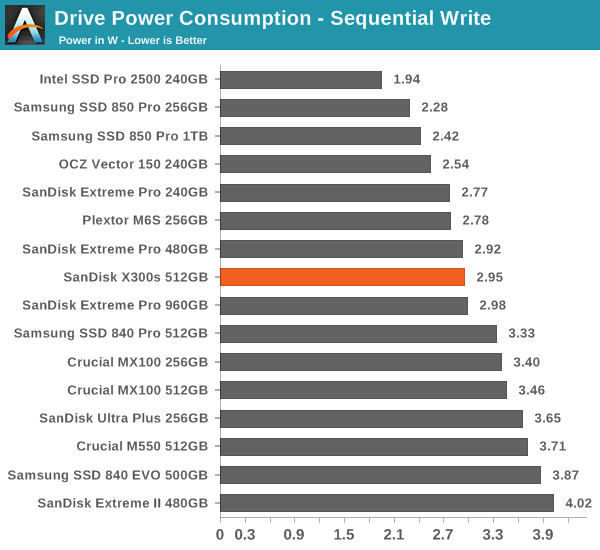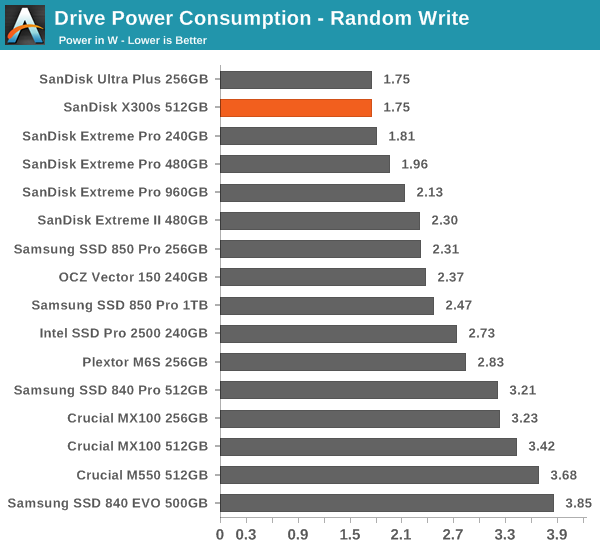SanDisk X300s (512GB) Review
by Kristian Vättö on August 21, 2014 2:15 PM ESTPower Consumption
Slumber power is lower than the Extreme Pro and overall very good. Only the 850 Pro is more power efficient, although Samsung has always had an advantage in idle/slumber power consumption. Load power consumption is also great and below average. Overall, the X300s would be a good option for a laptop and it should help battery life relative to some alternatives.













34 Comments
View All Comments
hojnikb - Friday, August 22, 2014 - link
*at a cost of capacity :) :)Kristian Vättö - Friday, August 22, 2014 - link
Yeah, fundamentally SLC, MLC and TLC are the same. Of course there are some silicon level optimizations to better fit the characteristics of each technology but the underlaying physics are the same.I'm thinking that pseudo-SLC is effectively just combining the voltage states of MLC/TLC. I.e. output of 11 or 10 from the NAND would read as 1, which allows for higher endurance since it doesn't matter if the actual voltage state switches from 11 to 10 due to the oxide wear out.
Spoony - Friday, August 22, 2014 - link
I believe you'd lose half the capacity on your drive. The MLC drives store two bits per cell, so they would store a 1 and a 0 for example. If you now are only allowing it to store a 1, then you've halved the capacity of the cell. Across the entire drive, this would thus halve the total drive capacity.As far as performance (read/write speed) I think this would be affected less. SSDs rely on parallelism to extract performance from NAND. The array is just as parallel as before. There might be an impact to performance having to do with extracting less information from each cell, how much this would be I'm not sure.
I think the changes to firmware would have to be much more substantial than just re-programming how many bits per cell are stored. There is most likely a lot of interesting logic around voltage handling at very small scales. Perhaps even looking at how voltages from neighbouring cells influence each other. I'm not sure how serious this firmware gets regarding physics, but it must have to do some sort of compensation because the drives seem pretty reliable.
hojnikb - Friday, August 22, 2014 - link
Yeah, ive "edited" the post to reflect the loss of capacity. Obviously capacity drops, but its still waay cheaper than real SLC solutions.I bet write speeds would actually go up (since this is the exact reason why samsung and sandisk are doing pSLC) but read would stay unaffected (since this is controller/interface limited anyway).
BillyONeal - Thursday, August 21, 2014 - link
Erm, what is MBAM for then? http://technet.microsoft.com/en-us/library/hh82607... My work PC has remotely managed BitLocker.
Zink - Thursday, August 21, 2014 - link
MBAM is "Malwarebytes Anti-Malware" malware removal toolBillyONeal - Thursday, August 21, 2014 - link
@Zink: It is also "Microsoft Bitlocker Administration and Management"Kristian Vättö - Thursday, August 21, 2014 - link
Looks like I should have done my research better. Thanks for the heads up, I've edited the review to remove the incorrect reference.thecoolnessrune - Thursday, August 21, 2014 - link
Yep, I the company I work with also has all of our drives encrypted with Bitlocker. It's managed by MBAM and integrated right into the rest of Active Directory Management. Really simple for the Domain Administrators (and relevant IT HelpDesk personnel) to use and manage.eDrive can fit in the Enterprise environment quite well.
cbf - Thursday, August 21, 2014 - link
Yup. As the other commenters indicate, the only thing we care about in the Enterprise is BitLocker. Hell, even if it was my personal drive, I'd probably only use BitLocker. I just trust it more than the third party solutions.So why don't you review this drive's encryption features using BitLocker. Anand showed how to do this last April: http://www.anandtech.com/show/6891/hardware-accele...